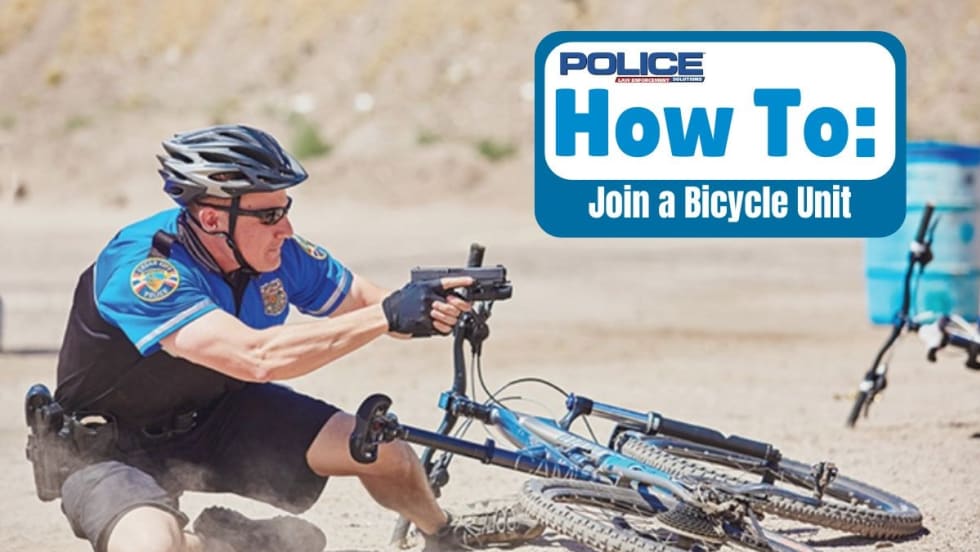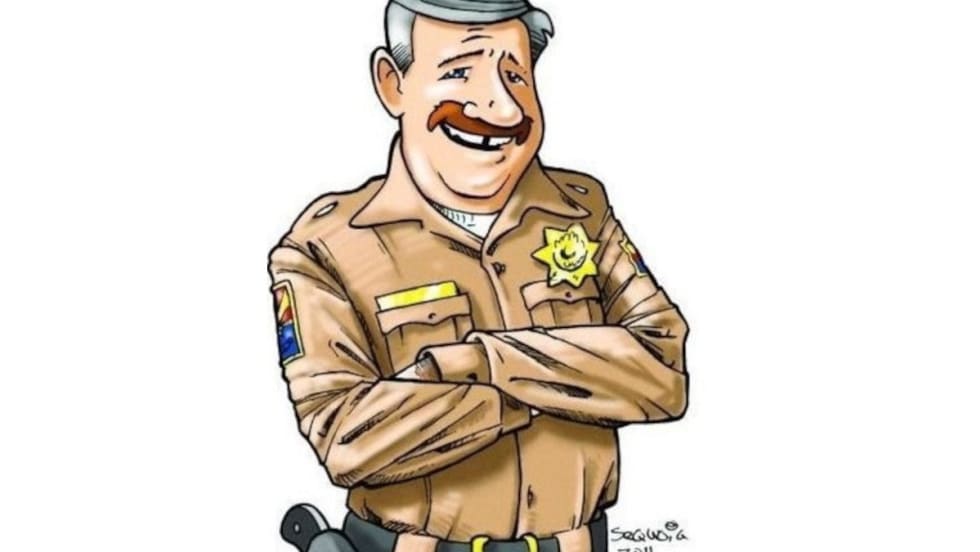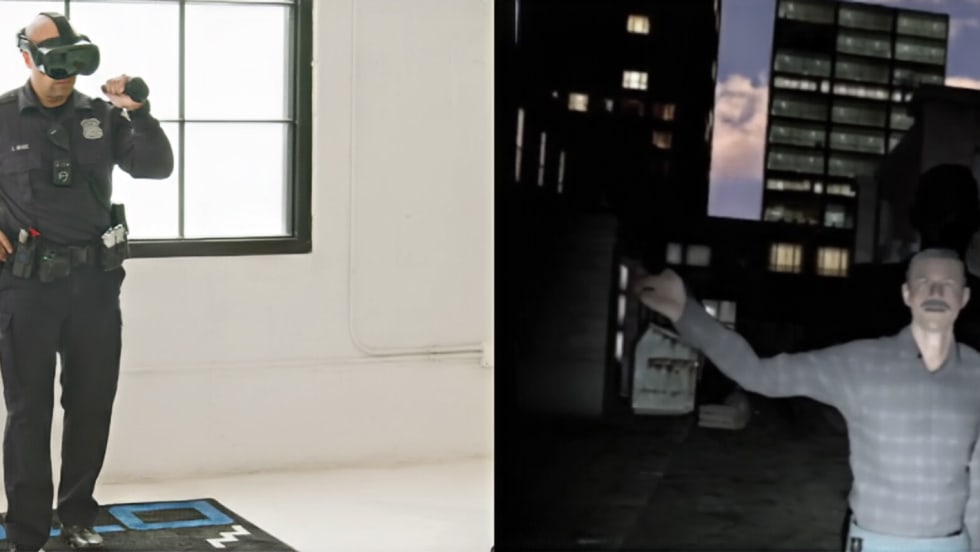The concept of de-escalating confrontations between law enforcement officers and subjects/suspects is nothing new. It has long been the goal of wise police officers to try to talk people into compliance and when necessary to achieve compliance use as little force as necessary. It was even once given the fancy name of “verbal judo” and taught to officers as a way to persuade people to let you arrest them peacefully.
10 Tips for Better De-Escalation Training
Knowing how to defuse a situation without force is essential for effective policing. It can prevent injury to officers, the public, and the subject.

Wearing the proper protection is critical to officer and role player safety when using marking rounds in training scenarios.
Doug Kazensky
“De-escalation” became a buzzword in law enforcement in the aftermath of the fatal officer-involved shooting of 19-year-old Michael Brown in Ferguson, Missouri. That August 2014 OIS was examined and analyzed by both local and federal prosecutors and investigators, and the conclusion was that it was justified. But Ferguson and other incidents of police force led to calls for more de-escalation training.
But not all de-escalation training is created equal. You can’t expect every person you contact to comply after you attempt de-escalation. So effective de-escalation training can’t just be about cops talking and observing while a subject or suspect commits illegal acts and presents a threat to the public. Effective de-escalation training has to cover what to do when de-escalation fails and force is required.
Effective de-escalation training also has to consider the legal foundation for law enforcement using force as established in such U.S. Supreme Court decisions as Graham v Connor and Tennessee v Garner. Officers must know when force is justified and what level of force is constitutional.
POLICE spoke with Doug Kazensky, a retired training sergeant who served with a Northwest agency, about his advice on how to build de-escalation training that covers how to de-escalate, when to de-escalate, when force is warranted and legal, and how to maintain officer safety.
1. Have Training Goals
Perhaps the most critical thing that the trainer must know before developing any law enforcement training is what is the purpose of the training. What does the agency need the officers to learn? What are the goals of the training?
“You don’t want to conduct the training and then reverse engineer the training objectives. And you never want to wing it.,” Kazensky says.
Another critical aspect of developing the program is making sure that everyone involved in presenting the training or executing the scenario understands the goals. This can be especially important if you are using role players. Kazensky recommends having a chat with the role players. “I tell them what I expect from them and let them know not to overdo it,” he says. “You have to let them know that you don’t want them to go all crazy because it will mess up what we are trying to do.”
2. Define De-escalation
Law enforcement officers have heard a lot about de-escalation and often have pre-existing thoughts on the subject. So it’s very important that the training covers what de-escalation is, what it is not, and what the agency expects of its officers.
“It’s not about placating the subject or bowing down or backing out,” Kazensky says. “It’s about securing a situation and slowing things down in order to establish communication. The ultimate goal is to avoid using force when it’s possible to do so.”
3. Preload the Content
Long before the current nationwide shortage of law enforcement officers, taking cops off the street for training was one of the most expensive aspects of maintaining an agency. If one group of officers is in training, another group has to cover, and that can mean overtime. Today the problem is even worse because in many places there are not enough officers to cover while others are in training.
Training hours are precious. And that’s why Kazensky recommends skipping classroom time as much as possible by teaching the officers the necessary background information that would be covered in a classroom before they arrive for training.
Kazensky is a senior solutions engineer for Vector Solution, the company that makes one of the most widely used platforms for online law enforcement training, so he’s a big advocate for internet based training. But there are less high-tech options for “preloading” classroom education before the actual date of the training session. For example, agencies can use paper handouts. They can also set aside a few minutes at roll call for short training modules.
Kazensky says information that should be “preloaded” into officers before de-escalation scenario training should include use-of-force law and agency policy. Doing so maximizes the benefit of scenario training.
4. Teach Them to Communicate
The most critical skill that officers must have to successfully de-escalate situations that can be safely de-escalated is the ability to communicate. That doesn’t mean barking orders at the person. It means talking to them human to human. It’s not an easy thing for many of today’s younger law enforcement officers to learn.
People in their 20s now were children when the iPhone debuted in 2007. More than any other technology, Smartphones have affected how people communicate. Many young people are more comfortable texting than talking.
Kazensky teaches an online criminal justice class for a community college in his area. In his class he makes his students record a video of them talking, and he urges agencies to make their younger officers talk to people. “You have to push them out of their comfort zone,” he says. “You need to get them out there interacting with people.”
5. Use Training Tools
There are a wide variety of tools available to help agencies train their officers. Some of the most exciting are the high-tech systems such as the VR simulators now being released by companies like VirTra, MILO, and Axon. VR is an excellent technology for de-escalation training because the nature of the scenarios require officers to interact with the subjects.
Of course VR systems are not practical for many cash-strapped agencies. Kazensky says training tools do not have to be high-tech to be effective. They can be very simple and very inexpensive, including things like Blue Guns, Airsoft, and marking rounds such as Simunition.
When Kazensky was head of training for his agency, he made effective use of a bed sheet to introduce quick decision-making to the training. “In these decision drills, a role player would come out from behind the sheet, which was hanging up in the training area, and the officer had to quickly decide what they were dealing with. Sometimes it was a threat and sometimes it was a person who needed help. The officers had to react appropriately,” he says.
6. Teach the Options
De-escalation is about finding a way to stabilize a situation without using force, if it is safe to do so. In order to achieve that stability, the officer must learn to use their options. It’s about not rushing in when it’s not necessary to do so. Time, distance, and cover are critical to successful de-escalation.
That’s why Kazensky says every de-escalation training scenario doesn’t have to immediately throw the officer into a chaotic, dynamic scene where they have little choice but to use force.
He says trainers need to mix it up. “You need scenarios where immediate action is necessary. But you also want progression-type scenarios where the officer can determine if they need to dive right in or are they going to step back. They also need to think about do they need cover. Do they need a cover officer. Can they communicate with the person? The officers need to be able to identify the opportunities to slow things down,” he explains.
Kazensky says the best de-escalation scenarios help officers think on their feet when they get involved in similar situations on the street. “In that actual incident, they need to recognize that situation from their training and draw from the foundation of what they learned,” he explains.
7. Have a Definition of Success
Effective training is about teaching officers the skills they need to do the job. So its essential that trainers and students know when the student has successfully completed the scenario or scenarios.
Trainers have to be hard and willing to fail the officers, Kazensky says it is not the goal to defeat the trainees or force them into no-win situations. “We don’t ever want to end scenario-based training with the officer thinking ‘Boy, I really bombed that.’ And then they go back out on the street. We want them to walk out of the training thinking ‘I know I can do this.’”
He stresses it’s very important that the officer comes away with a “win” even if they need to repeat the training to get there. “We need to address it immediately,” he says.
8. Debrief the Trainees
The old saw for teaching medical procedures is “see one, do one, teach one.” There’s a similar concept in law enforcement training. The trainee must learn what they can legally do, how to do it, do it, and then how to articulate why they did it.”
How and why is the essence of law enforcement training. In a legal case, the actions of an officer and why the officer took that action is the basis of whether an officer’s response was justified.
When an officer completes a scenario, you want them to be able to articulate exactly how and why they did what they did. That’s the most important element of a police report. That’s why the best trainers perform a debrief with their students after each scenario.
“You want to build your training around the law and teaching officers what they can do legally and how to articulate it. You want them to articulate it to you,” Kazensky says.
9. Once is Not Enough
Officers can’t just take one class on de-escalation, successfully complete the scenarios, get debriefed, and that’s it. Learning how to defuse fraught situations before they escalate into a use of force, is a career-long process.
“It’s not one-and-done training,” says Kazensky. “There’s elements that you are layering on top of each other. So before you start doing that, you need the base and then you build from there.”
Agencies hearing they have to repeat de-escalation training probably think the cost will be prohibitive. Kazensky says that’s probably not the case. De-escalation training doesn’t necessarily require expensive equipment nor does it require agencies taking officers off of the street.
During a webinar now available on PoliceMag.com titled “How to Support More Effective De-Escalation and Use-of-Force Training,” Kazensky and retired training sergeant Allan Payne discussed an inexpensive alternative for refresher sessions.
They recommend micro-training during role call. “You can take a few minutes and test the officers’ thought processes,” Kazensky says. The trainer gives the officers a scenario and has them write out their solution for handling it. “Or they can watch a video and discuss. Because of body-worn cameras, there is now an immense amount of training videos available.”
10. Tracking and Records
Law enforcement training is primarily about teaching officers how to avoid attacks, safely end confrontations, or apply the legal amount force effectively when necessary. But its also about fulfilling necessary training requirements for certification. So maintaining records and tracking the training are essential both for the officer and the agency.
Having all of the program information, including completion notes and evaluations available in a digital training platform is a good way to maintain the records. And maintaining the records is important. If the officer transfers, he or she will need the records. If a use of force should happen and it leads to litigation, the lawyers are going to be demanding them and the agency better be able to produce them to both their own attorneys and the plaintiff’s attorneys.
For more information on de-escalation training, go to https://www.policemag.com/webinars/webinar/15668074/vector-solutions-how-to-support-more-effective-deescalation-and-useofforce-training and watch “How to Support More Effective De-Escalation and Use-of-Force Training,” presented by Vector Solutions.
More Training

Caswell Live Fire Spins Off from InVeris
Caswell Live Fire has spun off from parent company InVeris, coinciding with the 100th anniversary of Caswell’s founding. Over the past 100 years, Caswell has developed pioneering solutions that support military, law enforcement, and commercial clients worldwide.
Read More →
When Do You Transport a Wounded Officer Instead of Waiting for EMS?
Thumbnail for video series POLICE Topics, Tactics & Tips with a yellow headline that reads When Do You Transport a Wounded Officer Instead of Waiting for EMS?
Read More →
Coffee Break with Police Experts: Using Your Patrol Vehicle for Cover
In this video, hear from Dustin Mowery, a product specialist at Team Wendy, as he discusses how to best use a patrol vehicle for cover.
Read More →
Using Patrol Vehicles for Cover
While a patrol vehicle offers some cover protection when taking fire, remain mobile and don’t stick to one piece of cover indefinitely. Dustin Mowery, of Team Wendy, shares what he teaches about using vehicles as cover.
Read More →
San Francisco Police Recruit Dies in Training
Recruit Officer Jon-Marques Psalms, 30, reportedly suffered a medical emergency after completing a training exercise on Wednesday August 20, 2025, at the Academy.
Read More →
POLICE and Flock Safety Present Webinar on Combining LPR with Real-Time Video
The webinar titled “Beyond the Plate: Real-Time Video Intelligence for Police Operations” will show how pairing LPR data with live camera feeds delivers faster, safer, and more coordinated responses on everything from stolen vehicles to active BOLOs.
Read More →
How to Join a Bicycle Unit
A great bicycle officer has a strong service mentality, paramount knowledge of laws, a thirst for new knowledge, and someone who can adapt to change easily. If this describes you, your agency's bicycle unit might be a good fit.
Read More →
Dave Smith: Be Prepared for the Ultimate Contest
You need to train like an elite athlete for the life-and-death challenge you may some day face on the job.
Read More →
First Look: Adding AI to Simulator Training
The new artificial intelligence feature for MILO’s VR and Focus3D simulators gives trainees a chance to practice and refine their communications skills while working scenarios.
Read More →


